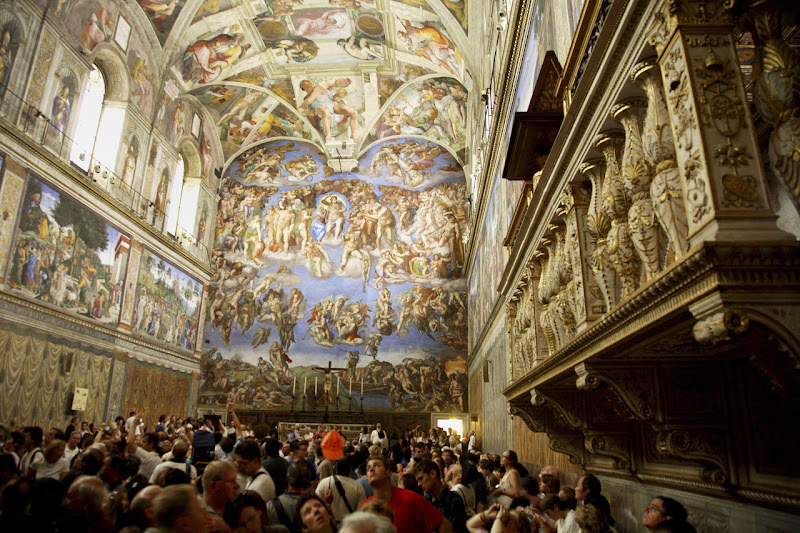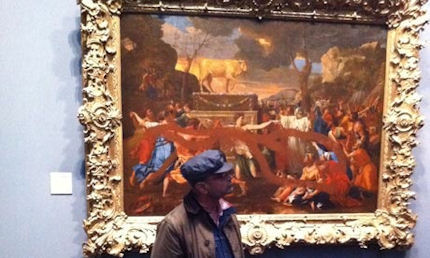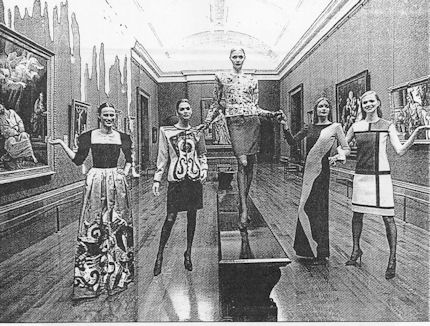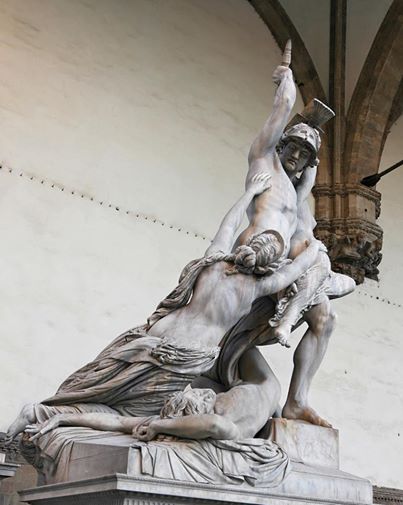Whatever happened to “Do not touch”?
Works of art are under physical threat as never before and proper contemplation of them is being made impossible. Aside from the absolute nihilistic depredations of Isil, within the West itself it is now feared that the long-chronicled growth of mass-tourism and its associated delinquent behavioral patterns – is about to create cultural gridlock in Europe.
SPECIES OF ABUSE
Something has to give. As things stand in the visual arts, the pressures for endless year-on-year growth in visitor numbers are irresistible even though the deleterious consequences are already manifest. While theatre, concert hall and cinema venues are designed (and behaviour therein is regulated) so as to permit all present to see, hear and think their own thoughts in companionable collectivity, in galleries and museums there are no such constraints on numbers or behaviour. In the remorseless drive to increase the “through-put” of paying visitors, people are packed and jostled into over-heating galleries in conditions that deny time and space for contemplation. The magnitude of this deterioration is shaming. The effects are exacerbated by restricted hours of paying-public access in order to provide privileged evening viewing to, for example, the clients of corporations which sponsor exhibitions or restorations – which organisations find the accruing good will to be a cost-effective form of self-promotion (see “Leaving your mark” below). The unfolding arithmetic of crush is terrifying.
In 2012 the annual number of international tourists passed one billion for the first time. In Britain what the Arts Council terms “The UK arts and culture industry”, generated £12.4billion in 2011. The Museums Association reports that in 2013 visits at the National Gallery were 14% higher than in the previous year and were 20% higher at the British Museum. Such rates of increase are unsustainable but for administering directors and trustees this “rising footfall” is taken to testify to the “enduring success” of museums. China is now the world’s largest contributor to this growth with its tourists spending over $100 billion in 2012. According to World Tourism Organization statistics, the Chinese are projected to take some 100 million overseas trips a year by 2020 – a twenty-five per cent increase on present levels. The Wall Street Journal reports that with the U.S. dollar about twenty-five per cent stronger against the euro than this time last year, bookings at the Louvre and the Sistine Chapel are sixty per cent higher this year than last (Europe Braces for a Summer Travel Crush, WSJ, 28 May).
The threat to the Sistine Chapel frescoes
With regard to the Sistine Chapel, the prospect is truly horrendous: we have already had confirmation of how the present visitor numbers are exacerbating the partial destruction of the frescoes that was begun in 1980 by the multi-million dollars Nippon TV-sponsored cleaning (see Michelangelo’s disintegrating frescoes).


Above, top: The Sistine Chapel ceiling during cleaning showing (at the bottom, below the scaffolding) the last surviving section of Michelangelo’s original two-stages painting.
Above, the stripped-down, first-stage ceiling, as experienced in the chapel today.
Systemic overcrowding in museums


Above, top: The Mona Lisa at the Louvre.
Above, centre: Rembrandt’s The Night Watch at the Rijksmuseum.
Above: The temporary exhibition “Late Rembrandt” at the Rijksmuseum. The Grumpy Art Historian described the over-crowding at this blockbuster as “the worst I can recall” and reported that the museum’s director, Wim Pijbes, had responded to criticisms by saying that “if you want a contemplative experience you should buy your own Rembrandt”.
“Roll up! Roll up!”


Above, top: A poster on the London Underground showing Turner’s (restorations-wrecked) painting Rockets and Blue Lights in the promotional campaign that accompanied the launch of the National Maritime Museum’s exhibition “Turner and the Sea”. For an account of that and other advertising campaigns, see “From Veronese to Turner, Celebrating Restoration-Wrecked Pictures“.
Above: One of “many plugs for the Rijksmuseum’s ‘Late Rembrandt’ exhibition” spotted at Amsterdam airport on May 14th by the art history blogger Bendor Grosvenor.
“Eyes down!”


Above, top: Otherwise engaged teenagers at the Rijksmuseum.
Above: McClachlan’s masterly take in Private Eye on other otherwise engaged victims of the near-universal mobile phone addiction.
Taking Possession of the Past



Above, top: Morgan Schweitzer’s illustration for the Ellen Gamerman, Inti Landauro and Liam MoloneyWall Street Journal article “Europe Braces for a Summer Travel Crush”.
Above, and above centre: Images from bing’s feature “Properly Posing with Statues“
Leaving your mark

Above: A (French) visitor at the National Gallery who, following reductions in warding staff, had time to deface two Poussin paintings with spray-paints on 16 July 2011. See “Dicing with Art and Earning Approval”.

Above: In 1999 the National Gallery allowed the Yves Saint Lauren fashion house to shoot a display of art-inspired clothing at the unveiling of the gallery’s Room 22, the £1m refurbishment of which had been met by the French fashion house. Not long afterwards we encountered a wall stripped of paintings and bearing massive water stains caused by rain which had overwhelmed the new guttering. We indicated the extent of water damage with white paint in the spring 1999 ArtWatch UK newsletter. The hastily removed paintings had included Le Valentin’s Four Ages of Man and Philippe de Champaigne’s The Vision of St Joseph.
Assaults on sculpture


Above: the Huffington Post reported in August last year that an American tourist broke a finger off a statue at the Museo dell’Opera del Duomo in Firenze, Italy. A security guard monitoring the exhibit had intervened immediately but, apparently, a moment too late.
One 3 June 2015, THE LOCAL reported that “Vandals in Florence have broken a finger off Pio Fedi’s famous statue of the Rape of Polyxena, Italian media has reported [See below]. It’s only the latest act of vandalism by careless visitors to the city.”
Florence’s mayor Dario Nardella is said to have called for harsher punishments for vandals.
“Damaging art is one of the most horrific and cowardly acts possible. I hope that the vandal who damaged the Rape of Polyxena yesterday in the Loggia dei Lanzi will be brought to justice soon,” Nardella wrote on Tuesday.
“Whoever strikes culture strikes at the heart of history and the identity of a community. I will be promoting harsher punishments for crimes against artistic heritage in parliament, as with environmental crimes, with imprisonment of up to 15 years and double the limitation periods.”


Above: On May 4th artnet reported that in Cremona, Italy, the Statue of the Two Hercules (circa 1700 and now, with its central coat of arms, effectively a symbol of the city itself) had been damaged as: “The scourge of the selfie has struck again: over the weekend, a pair of tourists accidentally broke an Italian sculpture while taking a photo with it, knocking off a portion of the statue’s crown, which shattered on the ground.” For other instance of selfie-takers’ damage, see Selfie-Taker Smashes Priceless Historic Italian Statue of Hercules
“Ding Minhao was here”

Above: The International Business Times has reported that a 3,500-year-old Egyptian carving in the Temple of Luxor had been defaced by a Chinese teenager with the words “Ding Minhao was here”. The paper also reported that China’s Vice Premier Wang Yang had earlier contended the country’s reputation overseas was being tarnished by the “uncivilized behavior” of some Chinese tourists. Wang made the remarks about the nation’s tourists during a teleconference held by the State Council, China’s cabinet, stressing that tourists need to be on good behavior when traveling abroad, according to the state-owned Xinhua News Agency.
Wang was reportedly referring to the poor manners and low “quality and breeding” of some Chinese tourists, saying they have harmed China’s international image, People’s Daily reported. “They speak loudly in public, carve characters on tourist attractions, cross the road when the traffic lights are still red, spit anywhere and [carry out] some other uncivilized behavior. It damages the image of the Chinese people and has a very bad impact.” In the wake of Wang’s words, the identity of the Luxor vandal emerged on Chinese social media. In an interview with Nanjing newspaper Modern Express on Saturday, the parents apologetically said it was the lack of education and supervision that led to their son’s mischievous behavior.
“We have taken him sightseeing since he was little, and we often saw such graffiti. But we didn’t realize we should have told him this is wrong,” the boy’s mother said in the interview, adding that she hopes China’s relentless Internet users stop tracking down her son, who had “cried all night.” The boy’s father said the boy had realized his mistake, and hopes that the public will give his young son a chance to fix his mistake and move on.
Nothing is sacred or inviolable
Above: Sadly necessary security measures in a Cotswold church.
Michael Daley, 1 June 2015
Grumpy Art Historian draws our attention to a further deliquency encountered among Chinese tourists: “Nature Vandalism”. In a Shanghai Daily report, (City’s parks tormented by ‘nature vandals’), it is said that:
“SHANGHAI Chenshan Botanical Garden is enhancing park patrols and adding volunteer monitors to address a growing problem of nature vandalism. Among recent incidents are Chinese characters carved onto the giant leaves of aloe and American century plants. The garden isn’t the only park in Shanghai suffering from public abuse. Other popular sites report problems arising from people who don’t seem to respect the native environment”.
Below: A yucca plant at Shanghai Chenshan Botanical Garden is covered in Chinese characters carved by vandals.

